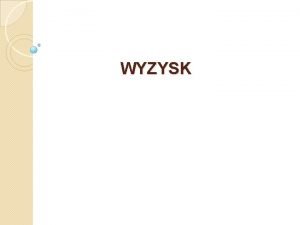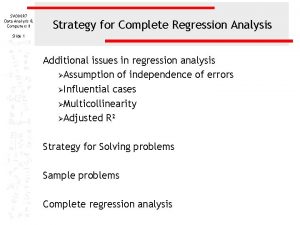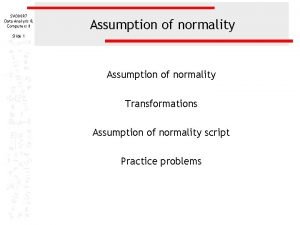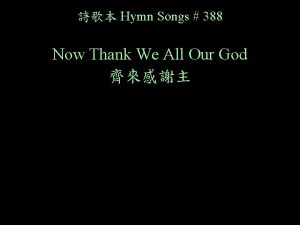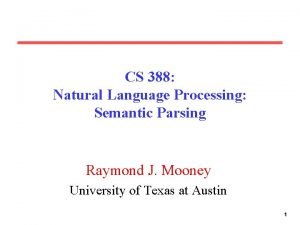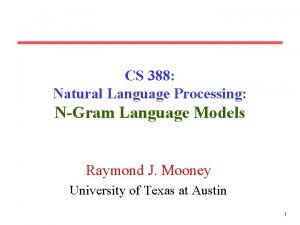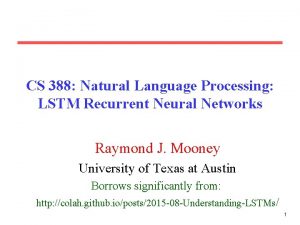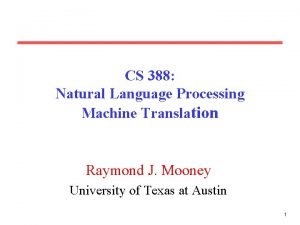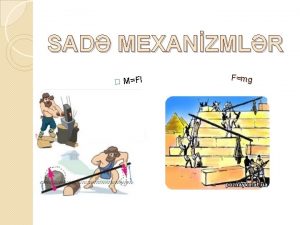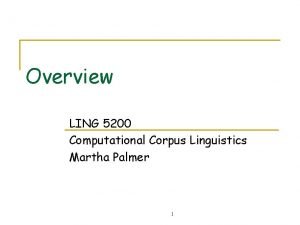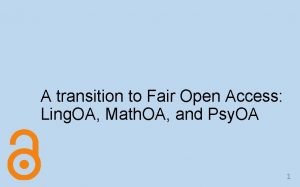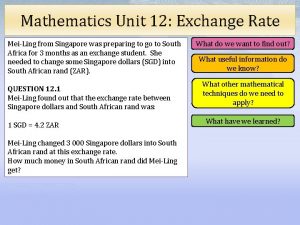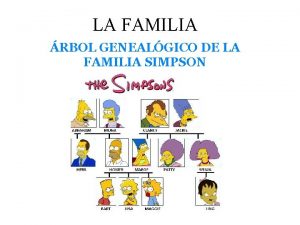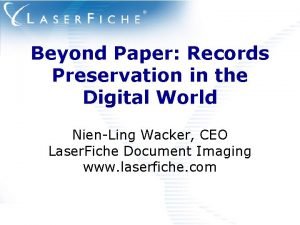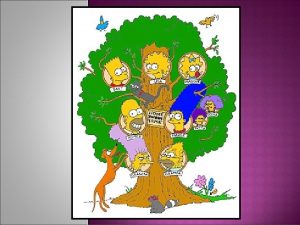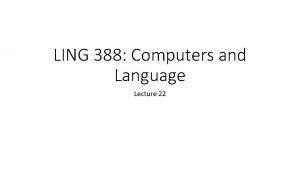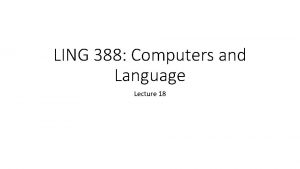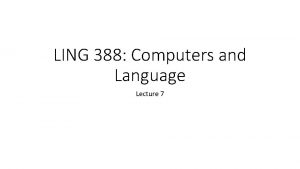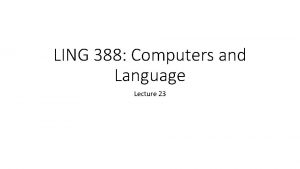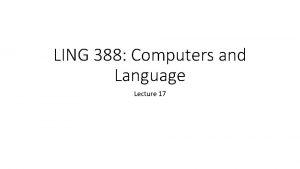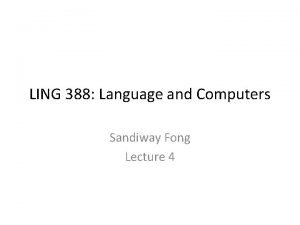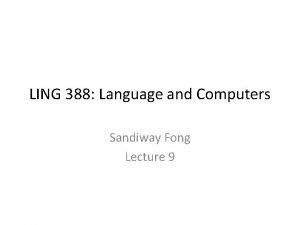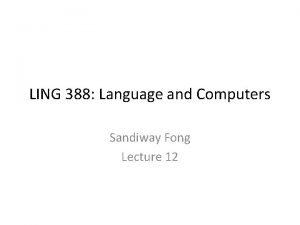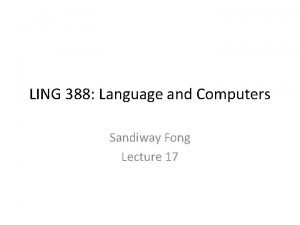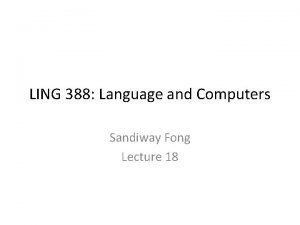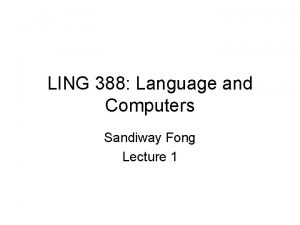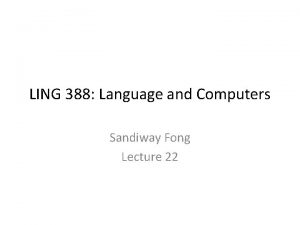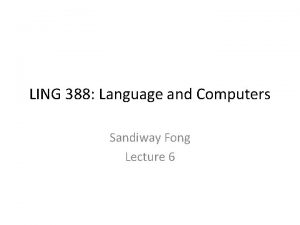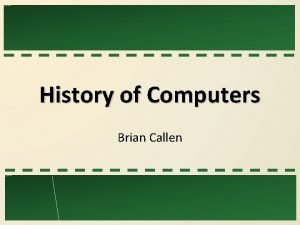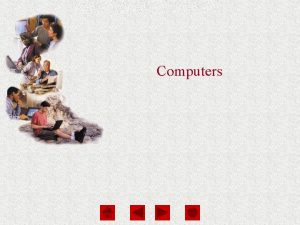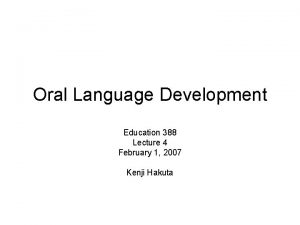LING 388 Computers and Language Lecture 5 Administrivia




















- Slides: 20

LING 388: Computers and Language Lecture 5

Administrivia • What's underneath Python: a deep dive … story continues • Quick Homework 4: due tomorrow midnight

Central idea: everything is in binary… • Not quite true in the case of solid state drives (SSDs) in your laptops:

Introduction: data types • Typically 32 bits (4 bytes) are used to store an integer • range: -2, 147, 483, 648 (231 -1 -1) to 2, 147, 483, 647 (232 -1 -1) 231 230 229 228 227 226 225 224 … byte 3 byte 2 … 27 byte 1 26 25 24 byte 0 23 22 21 20 C: int • using the 2’s complement representation • “to convert a positive integer X to its negative counterpart, flip all the bits, and add 1” • Example: • 00001010 = 23 + 21 = 10 (decimal) • 11110101 + 1 = 11110110 = -10 (decimal) • 11110110 flip + 1 = 00001001 + 1 = 00001010 Addition: -10 + 10 = 11110110 + 00001010 = 0 (ignore overflow)

Introduction: data types • Typically 32 bits (4 bytes) are used to store an integer • range: -2, 147, 483, 648 (231 -1 -1) to 2, 147, 483, 647 (232 -1 -1) byte 3 byte 2 byte 1 byte 0 • what if you want to store even larger numbers? C: int • Binary Coded Decimal (BCD) • code each decimal digit separately, use a string (sequence) of decimal digits …

Introduction: data types • Binary Coded Decimal (BCD) • 1 byte can code two digits (0 -9 requires 4 bits) • 1 nibble (4 bits) codes the sign (+/-), e. g. hex C/D 23 22 21 20 0 0 23 22 21 20 0 1 23 22 21 20 1 0 0 1 2 0 1 4 2 bytes (= 4 nibbles) 1 9 0 + 2 0 1 4 2. 5 bytes (= 5 nibbles) 23 1 credit (+) 22 21 1 0 20 0 C 23 debit (-) 22 21 20 1 1 0 1 D

Introduction: data types • Typically, 64 bits (8 bytes) are used to represent floating point numbers (double precision) C: • • c = 2. 99792458 x 108 (m/s) coefficient: 52 bits (implied 1, therefore treat as 53) exponent: 11 bits (not 2’s complement, unsigned with bias) x 86 CPUs have a built-in sign: 1 bit (+/-) float double floating point coprocessor (x 87) 80 bit long registers wikipedia

Example 1 • Recall the speed of light (from last side): • c = 2. 99792458 x 108 (m/s) 1. Can a 4 byte integer be used to represent c exactly? • • • 4 bytes = 32 bits in 2’s complement format Largest positive number is 231 -1 = 2, 147, 483, 647 c = 299, 792, 458 (in integer notation)

Example 2 • Recall again the speed of light: • c = 2. 99792458 x 108 (m/s) 2. How much memory would you need to encode c using BCD notation? • • 9 digits each digit requires 4 bits (a nibble) BCD notation includes a sign nibble total is 5 bytes

Example 3 • Recall the speed of light: • c = 2. 99792458 x 108 (m/s) 3. Can the 64 bit floating point representation (double) encode c without loss of precision? • Recall significand precision: 53 bits (52 explicitly stored) • 253 -1 = 9, 007, 199, 254, 740, 991 • almost 16 digits

Example 4 • Recall the speed of light: • c = 2. 99792458 x 108 (m/s) • The 32 bit floating point representation (float) – sometimes called single precision - is composed of 1 bit sign, 8 bits exponent (unsigned with bias 2(8 -1)-1), and 23 bits coefficient (24 bits effective). • Can it represent c without loss of precision? • 224 -1 = 16, 777, 215 • Nope

hw 4. xlsx

Quick Homework 4: Representing π • Using the supplied spreadsheet, compute the best 32 bit floating point approximation to π that you can come up with. • Submit a snapshot of the spreadsheet to me by email by tomorrow night • Reminder: one PDF file • Subject: 388 Your Name Homework 4

Introduction: data types • How about letters, punctuation, etc. ? • ASCII C: char • American Standard Code for Information Interchange • Based on English alphabet (upper and lower case) + space + digits + punctuation + control (Teletype Model 33) • Question: how many bits do we need? • 7 bits + 1 bit parity Teletype Model 33 ASR • Remember everything is in binary … Teleprinter (Wikipedia)

Introduction: data types order is important in sorting! 0 -9: there’s a connection with BCD. Notice: code 30 (hex) through 39 (hex)

Introduction: data types • Parity bit: • • transmission can be noisy parity bit can be added to ASCII code can spot single bit transmission errors even/odd parity: • receiver understands each byte should be even/odd • Example: • 0 (zero) is ASCII 30 (hex) = 011000 • even parity: 0110000, odd parity: 0110001 • Checking parity: • Exclusive or (XOR): basic machine instruction • A xor B true if either A or B true but not both • Example: x 86 assemby language: 1. PF: even parity flag set by arithmetic ops. 2. TEST: AND (don’t store result), sets PF 3. JP: jump if PF set Example: MOV al, <char> TEST al, al JP <location if even> <go here if odd> • (even parity 0) 0110000 xor bit by bit • 0 xor 1 = 1 xor 1 = 0 xor 0 = 0 xor 0 = 0

Introduction: data types • UTF-8 • standard in the post-ASCII world • backwards compatible with ASCII • (previously, different languages had multi-byte character sets that clashed) • Universal Character Set (UCS) Transformation Format 8 -bits (Wikipedia)

Introduction: data types • Example: • • • あ Hiragana letter A: UTF-8: E 38182 Byte 1: E = 1110, 3 = 0011 Byte 2: 8 = 1000, 1 = 0001 Byte 3: 8 = 1000, 2 = 0010 い Hiragana letter I: UTF-8: E 38184 Shift-JIS (Hex): あ: 82 A 0 い: 82 A 2

Introduction: data types • How can you tell what encoding your file is using? • Detecting UTF-8 • Microsoft: • 1 st three bytes in the file is EF BB BF • (not all software understands this; not everybody uses it) • HTML: • <meta http-equiv="Content-Type" content="text/html; charset=UTF-8" > • (not always present) • Analyze the file: • Find non-valid UTF-8 sequences: if found, not UTF-8… • Interesting paper: • http: //www-archive. mozilla. org/projects/intl/Universal. Charset. Detection. html

Introduction: data types • Text files: • text files have lines: how do we mark the end of a line? • End of line (EOL) control character(s): • LF 0 x 0 A (Mac/Linux), • CR 0 x 0 D (Old Macs), • CR+LF 0 x 0 D 0 A (Windows) • End of file (EOF) control character: • (EOT) 0 x 04 (aka Control-D) programming languages: NUL used to mark the end of a string binaryvision. nl

